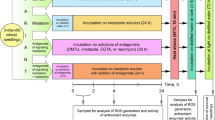Abstract
The reduction of dehydroascorbate, the oxidized form of ascorbate plays important role in the maintenance of sufficient level of ascorbate. In plant mitochondria two DHA reducing mechanisms, the GSH-dependent and the mitochondrial electron transfer chain dependent ascorbate recycling have been characterized. Although both pathways have been extensively studied quantitative information about the electron fluxes from one or another direction for the reduction of DHA is not known. The cellular, mitochondrial glutathione pools and mitochondrial DHA reducing capacity was measured in BSO treated and control tobacco cells. While BSO caused dramatic decrease of cellular GSH content the difference was much smoother at mitochondrial level. The difference in DHA reduction capacity was even smoother affirming the existence of alternative, non-GSH dependent DHA reducing mechanism(s) in plant mitochondria. On the base of the parallel determination of mitochondrial GSH content and ascorbate production upon DHA addition, GSH (consumption) is responsible for the ~ 20 % of ascorbate production. Almost 90 % enhancement of ascorbate production could be provoked by the addition of Complex II substrate succinate which could be almost totally prevented by the concomitant addition of malonate or TTFA. On the base of these results, the importance of mitochondrial Complex II compared to GSH-dependent mechanisms in mitochondrial ascorbate recycling has been underestimated so far.




Similar content being viewed by others
References
Chew O, Whelan J, Millar AH (2003) Molecular definition of the ascorbate-glutathione cycle in Arabidopsis mitochondria reveals dual targeting of antioxidant defenses in plants. J Biol Chem 278:46869–46877
Del Bello B, Maellaro E, Sugherini L, Santucci A, Comporti M, Casini AF (1994) Purification of NADPH-dependent dehydroascorbate reductase from rat liver and its identification with 3 α-hydroxysteroid dehydrogenase. Biochem J 304:385–390
Fernández-Checa JC (2003) Redox regulation and signaling lipids in mitochondrial apoptosis. Biochem Biophys Res Commun 304:471–479
Horemans N, Foyer CH, Potters G, Asard H (2000) Ascorbate function and associated transport systems in plants. Plant Physiol Biochem 38:531–540
Jimenez A, Hernandez JA, Del Rio LA, Sevilla F (1997) Evidence for the presence of the Ascorbate-Glutathione cycle in mitochondria and peroxisomes of pea leaves. Plant Physiol 114:275–284
Li X, Cobb CE, Hill KE, Burk RF, May JM (2001) Mitochondrial uptake and recycling of ascorbic acid. Arch Biochem Biophys 387:143–153
Li X, Cobb CE, May JM (2002) Mitochondrial recycling of ascorbic acid from dehydroascorbic acid: dependence on the electron transport chain. Arch Biochem Biophys 403:103–110
May JM, Mendiratta S, Hill KE, Burk RF (1997) Reduction of dehydroascorbate to ascorbate by the selenoenzyme thioredoxin reductase. J Biol Chem 272:22607–22610
Millar AH, Mittova V, Kiddle G, Heazlewood JL, Bartoli CG, Theodoulou FL, Foyer CH (2003) Control of ascorbate synthesis by respiration and its implications for stress responses. Plant Physiol 133:443–447
Murashige T, Skoog F (1962) A revised medium for rapid growth and bioassay with tobacco tissue cultures. Physiol Plant 15:473–497
Parsons HT, Fry SC (2012) Oxidation of dehydroascorbic acid and 2,3-diketogulonate under plant apoplastic conditions. Phytochemistry 75:41–49
Schertl P, Sunderhaus S, Klodmann J, Grozeff GE, Bartoli CG, Braun HP (2012) L-galactono-1,4-lactone dehydrogenase (GLDH) forms part of three subcomplexes of mitochondrial complex I in Arabidopsis thaliana. J Biol Chem 287:14412–14419
Szarka A, Horemans N, Bánhegyi G, Asard H (2004) Facilitated glucose and dehydroascorbate transport in plant mitochondria. Arch Biochem Biophys 428:73–80
Szarka A, Horemans N, Kovács Z, Gróf P, Mayer M, Bánhegyi G (2007) Dehydroascorbate reduction in plant mitochondria is coupled to the respiratory electron transfer chain. Physiol Plant 129:225–232
Szarka A, Tomasskovics B, Bánhegyi G (2012) The ascorbate-glutathione-α-tocopherol triad in abiotic stress response. Int J Mol Sci 13:4458–4483
Szarka A, Banhegyi G, Asard H (2013) The inter-relationship of ascorbate transport, metabolism and mitochondrial, plastidic respiration. Antioxid Redox Signal. doi:10.1089/ars.2012.5059
Wheeler GL, Jones MA, Smirnoff N (1998) The biosynthetic pathway of vitamin C in higher plants. Nature 393:365–369
Winkler BS (1987) In vitro oxidation of ascorbic acid and its prevention by GSH. Biochim Biophys Acta 925:258–264
Xu DP, Wells WW (1996) α-Lipoic acid dependent regeneration of ascorbic acid from dehydroascorbic acid in rat liver mitochondria. J Bioenerg Biomembr 28:77–85
Zechmann B, Müller M, Zellnig G (2006) Intracellular adaptations of glutathione content in Cucurbita pepo L. induced by treatment with reduced glutathione and buthionine sulfoximine. Protoplasma 227:197–209
Zechmann B, Mauch F, Sticher L, Müller M (2008) Subcellular immunocytochemical analysis detects the highest concentrations of glutathione in mitochondria and not in plastids. J Exp Bot 59:4017–4027
Acknowledgments
This work was financially supported by National Scientific Research Fund grants (OTKA 77826, 105416) and by the New Széchenyi Development Plan (TÁMOP-4.2.1/B-09/1/KMR-2010-0002).
Author information
Authors and Affiliations
Corresponding author
Additional information
Communicated by E. Schleiff.
Rights and permissions
About this article
Cite this article
Szarka, A. Quantitative data on the contribution of GSH and Complex II dependent ascorbate recycling in plant mitochondria. Acta Physiol Plant 35, 3245–3250 (2013). https://doi.org/10.1007/s11738-013-1359-x
Received:
Revised:
Accepted:
Published:
Issue Date:
DOI: https://doi.org/10.1007/s11738-013-1359-x




